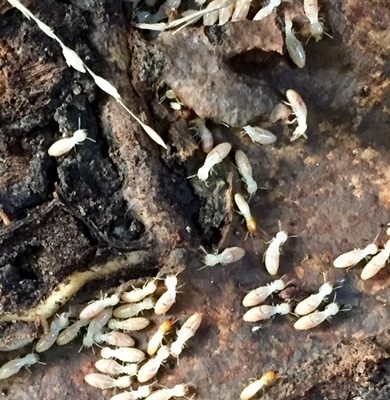Termite Control In Greater Melbourne
As they are often referred to as “white ants” or “wood ants”, termites are commonly thought to be a member of the ant family. However, the termite is actually classified, along with the cockroach, in the order, Blattodea. With over 3000 species, the general appearance of the termite is most usually small, measuring between 4 and 15 millimetres. Like many insects, the female queens are much larger than their male counterparts, with one species measuring up to 10 centimetres in length! The body of the termite is split into segments—head, thorax and ten-segmented abdomen—while, interestingly, most worker termites are completely blind as they do not have eyes.
Like bees and wasps, the termite is a eusocial insect, building a society where labour is divided among various castes. Sterile male and female worker termites carry out most of the tasks for the rest of the colony, and are responsible for foraging, food storage, and brood and nest maintenance. As workers are the termites digesting the cellulose to make the nest, they are the caste most commonly found in infested wooden homes and abandoned structures. The winged, fertile castes of male ‘kings’ and female ‘queens’ are responsible solely for reproduction.
For these reasons, termite colonies are often described as ‘superorganisms’ because the individual insects form part of a self-regulating entity: the colony itself. These colonies live in nests that are composed of two parts: the inanimate (still) and the animate (living). The inanimate nest consists of all the termites living inside the nest, while the inanimate nest is the structure itself, made primarily from termite faeces (partly digested plant matter).
Termite nests take of different forms and can be separated into three main categories: subterranean (completely below ground), epigeal (protruding above the soil surface), and arboreal (built above ground, but always connected to the ground via what is known as ‘shelter tubes’). The function of the nest is to act as a protected living space and provide shelter from predators. The most common type of termite nest is those found underground. However, the termite nest most dreaded by humans is, of course, the one that occupies the wooden structures of houses. Drywood termites are termites known to consume, often quite subtly for years, the foundations of houses and structures in warm climates; these termites can also occupy heated structures in cooler climates.
It is important to prevent termite attacks in your home or work property, as Melbourne has reached higher than usual levels of infestation over the past two years due to warmer weather conditions. If your home or work property has become been infested with this destructive guest, call the expert termite removers at Right Pest Control on 0478 308 361.








